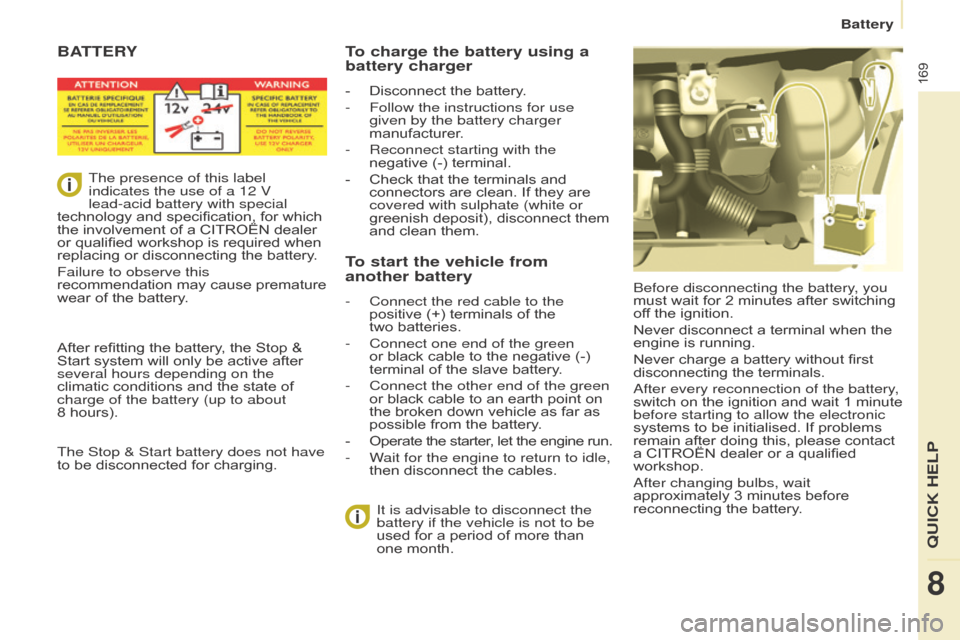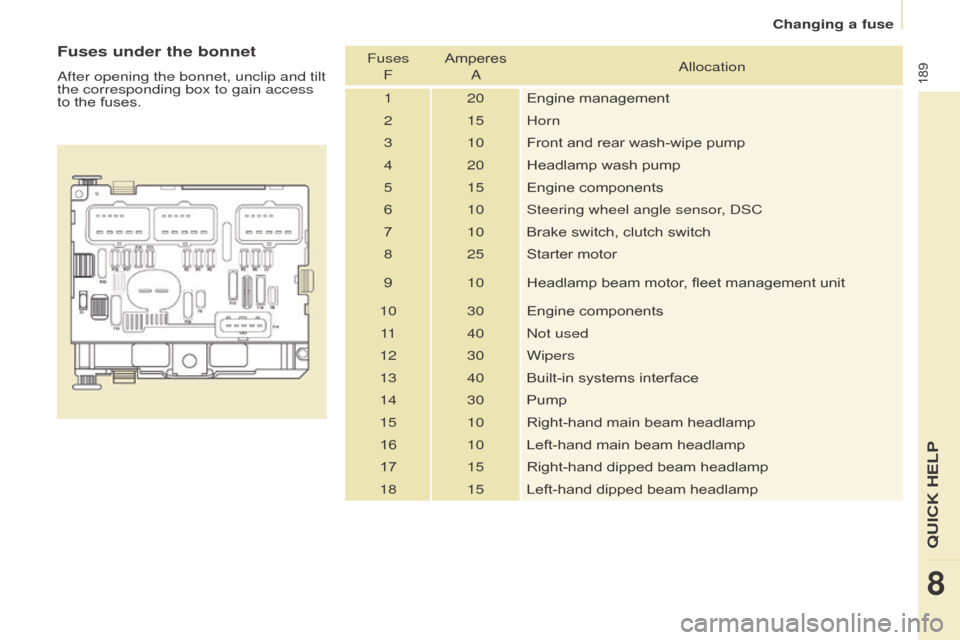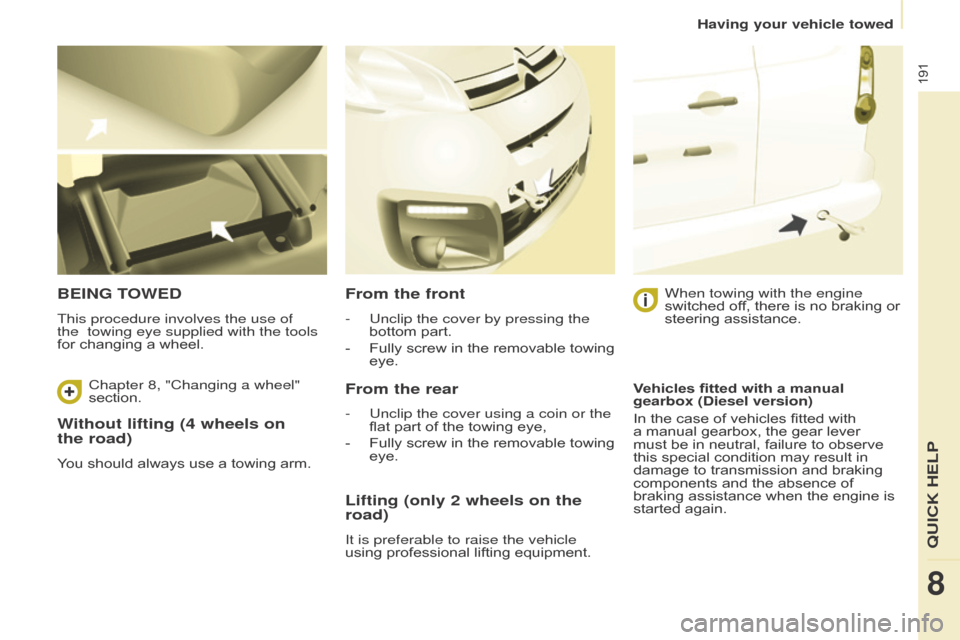engine Citroen BERLINGO MULTISPACE RHD 2015.5 2.G Service Manual
[x] Cancel search | Manufacturer: CITROEN, Model Year: 2015.5, Model line: BERLINGO MULTISPACE RHD, Model: Citroen BERLINGO MULTISPACE RHD 2015.5 2.GPages: 292, PDF Size: 10.74 MB
Page 165 of 292

163
Berlingo-2-VP_en_Chap07_Verification_ed02-2015
AdBlue® additive
Berlingo-2-VP_en_Chap07_Verification_ed02-2015
BLUEHDI
AND A D B LUE
® ADDITIVE
The technology
adBlue® is the brand name of the solution needed for operation of the
SCR
system. BlueHDi
vehicles have a specific
a dBlue
® additive tank with a capacity
of 17 litres .
It
has
an exterior filler with a blue filler
cap, located to the left of the
d iesel
fuel
filler cap.
Filling of the
a
dBlue
® tank can be done using 5 or 10 litre containers,
1.89
litre
bottles,
or
when at a fuel
fillin
g
station
equipped with a special
a
dBlue
® delivery pump for light vehicles.
The
objective
of
BlueHDi
is
to
reduce
by
up
to
90%
the
emissions
of
NOx
(nitrous oxides) in the air
, using a
system
that
converts
NOx
into
water
vapour and nitrogen in a dedicated
catalytic
converter:
SCR
(Selective
Catalytic
Reduction).
This
objective
meets
the
"Euro"
emissions
standard
adopted
by
the
European
Union
aimed
at
limiting
the
emissions
of
pollutants
from
internal
combustion
engines.
The BlueH
d
i generation of engines
allow
the
"Euro
6"
European
standard
to
be
met,
with
an
extra
tank
to
hold
the
a
dBlue
® fluid for the treatment of exhaust
gases.
This operation can also be carried
out by a CITR
o Ë n dealer or a
qualified
workshop.
Please note that the high delivery
pumps
at some filling stations,
intended only for lorries and coaches,
are not suitable for cars or light
commercial
vehicles.
Never
use these pumps.
CHECKS
7
Page 167 of 292

165
Berlingo-2-VP_en_Chap07_Verification_ed02-2015
AdBlue® additive
Berlingo-2-VP_en_Chap07_Verification_ed02-2015
Range indicators
Rules on the display of alertsFor more information on the
displays
and warning lamps, refer
to
chapter 3, "Instruments and
controls"
section. Range greater than 1 500 miles
(2 400 km)
No
information displayed.
Once the 1 500 miles (2 400 km)
threshold is reached, the URE
a
warning
lamp comes on temporarily
and
the remaining range message is
displayed.
The
alert is repeated every 150 miles
(300
km) until the next threshold is
reached.
Every
time the ignition is switched
on, the alert is given, together with an
audible
signal.
Remaining range less than
1 500 miles (2 400 km) and greater
than 350 miles (600 km)
Driving range
With
the touch screen tablet:
If
the range is greater than 3 000 miles
(5
000 km), a range value is not given.
Press this button to display
the
information.
-
select the "
d riving
assistance"
menu,
-
select "
d iagnostic",
-
select
CHECK.
d
ifferent levels of alert are triggered
according
to the remaining driving
range
threshold.
You
will be informed as each mileage
threshold is reached and the alerts will
change
from temporary to permanent.
-
The 1st is triggered at a remaining driving
range of 1 500 miles
(2
400
km).
-
The 2nd is triggered at a remaining driving
range of 350 miles (600 km).
-
Up
to
0 miles, at which point it will
be
impossible to restart the engine
after
a
stop.
CHECKS
7
Page 168 of 292

166
Berlingo-2-VP_en_Chap07_Verification_ed02-2015
AdBlue® additive
Berlingo-2-VP_en_Chap07_Verification_ed02-2015
Once the 350 miles (600 km) threshold is reached, the UREA warning lamp flashes
and the Service warning lamp
comes
on, accompanied by a message
on
the remaining driving range.
The alert is repeated every 30 seconds
with
an update of the remaining driving
range
in steps of 30 miles (50 km)
travelled.
Every
time the ignition is switched
on, the alert is given together with an
audible
signal.
At 0 miles the system installed in
the vehicle to meet the emissions
standard will prevent engine starting. The 0 level of
a
dBlue
® additive has
been
reached.
Your
vehicle's
exhaust emissions no
longer
meet
the
"Euro
6" standard and
the
engine
will
not
start.
To be able to restart the vehicle, you
must
add
at
least
4 litres of a dBlue
®.
-
Pour
the
additive
into
the
tank
(by
the
filler
with
the
blue
cap).
-
Switch on the ignition without
starting.
-
W
ait 10 seconds before starting the
engine.
Remaining range less than 350 miles
(600 km) and more than 0 miles
Starting prevented, breakdown
related to a lack of AdBlue
® additive
in the special tank
Avoid waiting until the
remaining range is 0 miles!
The alert is repeated when driving until
the
additive
tank
has
been
topped-up
with
sufficient
additive.
Unless the additive in the special
additive
tank
is
topped-up,
you
risk
immobilisation
of
the
vehicle. Following
this,
make
a
further fill
to
the
special
additive
tank, the
capacity of which is
17 litres.Fault with the SCR system
The UREa, Service and diagnostic
warning lamps comes on.
Every
time the ignition is switched on,
the
emissions fault is confirmed by an
audible
signal and a message.
If
it is a temporary fault, the alert
disappears as soon as the exhaust
emissions
return to the levels required
by
the standard.
Detection
o
n the other hand, if the warning
lamps
are still on after 30 miles
(50
km) of driving, the fault is
confirmed.
An
engine start prevention system
will
be activated automatically after
650 miles
(1 100 km) travelled
following
this confirmation.
Go
to a CITROËN dealer or a qualified
workshop.
o
r go to a CITR
o
Ë
n
dealer or a
qualified
workshop.
Page 169 of 292

167
Berlingo-2-VP_en_Chap07_Verification_ed02-2015
AdBlue® additive
Berlingo-2-VP_en_Chap07_Verification_ed02-2015
Fault confirmed
In addition to the previous signals,
the UREA
warning lamp flashes and
the
remaining range allowed will be
displayed
in miles (kilometres).
The alert will be repeated every
30
seconds with an update of the
driving
range in steps of 30 miles
(50 km).
Go
to a CITROËN dealer or a qualified
workshop
as soon as possible.
You
risk not being able to start the
engine.
Starting prevented, having
covered the 650 miles (1 100 km)
At
each attempt at starting, the alert is
activated
and the message "Emissions
fault:
Starting prevented" is displayed.Refilling / Topping-up the
AdBlue® additive
Precautions to take
Use only a dBlue® additive that meets the
ISO
22241
standard.
The
a
dBlue
® additive is an urea-based
solution.
This
liquid
is
non-flammable,
colourless
and
odourless.
To
be
kept
in a cool area.
Containers (5 or 10 litres) and
bottles (1.89 litres) of AdBlue
®
Please check the use-by date.
Read the instructions on the label.
Ensure that you have a suitable
filler
pipe, which may or may not be
supplied
with the container. In
the event of an overflow, wipe
around
the filler mouth using a
damp
cloth.
If any a dBlue
® fluid is split or splashed on
to
you,
wash immediately with cold
water or wipe yourself with a clean
damp
cloth.
If the additive has crystallised, clean it
off
using
a
sponge and hot water.
CHECKS
7
Page 170 of 292

168
Berlingo-2-VP_en_Chap07_Verification_ed02-2015
AdBlue® additive
Berlingo-2-VP_en_Chap07_Verification_ed02-2015
Filling
Ensure that the vehicle is parked on a flat and level surface.
Pour
the contents of the container /
bottle
into the dedicated tank.
After
filling the additive tank, observe
the
following procedure:
-
Switch on the ignition without
starting.
-
W
ait 10 seconds before starting the
engine.
Never
dispose of empty
AdBlue®
containers and bottles in the
household
waste.
Place
them
in
a
special
container
provided
this
purpose
or
take
them
to
your
dealer.
k
eep a dBlue
® out of the reach of
children,
in
its
original container.
n
ever transfer
a
dBlue
® to another
container:
it
would
loose its purity.
Never
dilute
the
additive with water.
n
ever pour the additive into the d iesel
fuel
tank.
Recommendations on storage
never store containers or bottles of a dBlue® in your vehicle.
Freezing of the AdBlue
® additive
a
dBlue® freezes at about -11°C (12.2°F)
and deteriorates above 25°C
(77°F).
It
is
recommended that containers and
bottles be stored in a cool area and
protected
from direct sunlight.
Under these conditions, the additive
can
be
kept for at least a year.
a
dditive that has been frozen can be
used
once it has thawed out in ambient
air
. The
SCR system includes an
a dBlue
® tank heater that ensures operation
of the vehicle in normal
conditions.
In exceptional situations, such as when
the
vehicle
is kept at temperatures
below
-15°C
(5°F) for a long period,
there
may
be an emission fault alert
related to freezing of the a
dBlue
®
additive.
Park
the
vehicle
in
an
area
at
a
more
moderate
temperature
for
a
few
hours
until
the
additive
becomes
a
liquid
again.
The
emissions
warning
lamp
does not
go
off
immediately,
but
does
so
after a
few
miles
of
driving.
Page 171 of 292

169
Berlingo-2-VP_en_Chap08_aide-rapide_ed02-2015
BATTERY
Before disconnecting the battery, you
must wait for 2 minutes after switching
of
f the ignition.
Never
disconnect a terminal when the
engine
is running.
Never
charge a battery without first
disconnecting
the terminals.
a
fter every reconnection of the battery,
switch
on the ignition and wait 1 minute
before starting to allow the electronic
systems
to be initialised. If problems
remain
after doing this, please contact
a
CITROËN dealer or a qualified
workshop.
a
fter changing bulbs, wait
approximately
3 minutes before
reconnecting
the battery.
It is advisable to disconnect the
battery if the vehicle is not to be
used
for
a
period
of
more
than
one month.
To charge the battery using a
battery charger
- Disconnect the battery.
-
Follow the instructions for use
given by the battery charger
manufacturer
.
-
Reconnect starting with the
negative
(-) terminal.
-
Check
that the terminals and
connectors
are clean. If they are
covered with sulphate (white or
greenish
deposit), disconnect them
and
clean them.
To start the vehicle from
another battery
- Connect the red cable to the
positive (+) terminals of the
two batteries.
-
Connect one end of the green
or
black cable to the negative (-)
terminal
of the slave battery.
-
Connect the other end of the green
or
black cable to an earth point on
the
broken down vehicle as far as
possible
from the battery.
-
Operate
the starter, let the engine run.
-
W
ait for the engine to return to idle,
then
disconnect the cables.
The presence of this label
indicates the use of a 12 V
lead-acid battery with special
technology
and
specification,
for
which
the
involvement
of
a
CITROËN
dealer
or
qualified
workshop
is
required
when
replacing
or
disconnecting
the
battery.
Failure to observe this
recommendation
may
cause
premature
wear
of
the
battery.
After
refitting
the
battery,
the
Stop &
Start
system
will
only
be
active
after
several hours depending on the
climatic
conditions
and
the
state
of
charge of the battery (up to about
8 hours).
The Stop & Start battery does not have
to
be
disconnected
for
charging.
Battery
QUICk HELP
8
Page 172 of 292

170
Berlingo-2-VP_en_Chap08_aide-rapide_ed02-2015
ECONOMY MODE
after the engine has stopped, with
the key in the ignition position, certain
functions (windscreen wiper
, electric
windows,
courtesy lamps, audio
equipment,
etc.) can only be used for a
cumulative
duration of thirty minutes, to
prevent
discharging of the battery.
Once
the thirty minutes have elapsed,
the active functions are put on standby
and
the battery warning lamp flashes
accompanied
by a message in the
screen.
T
o resume the use of these functions
immediately
, start the engine and let it
run
for a few minutes.
The
time available will then be double
the
time for which the engine was left
running.
However, this time will always
be
between five and thirty minutes.
A
flat battery will prevent the
engine
from starting.
Battery
Page 191 of 292

189
Berlingo-2-VP_en_Chap08_aide-rapide_ed02-2015Berlingo-2-VP_en_Chap08_aide-rapide_ed02-2015
Fuses under the bonnet
after opening the bonnet, unclip and tilt
the corresponding box to gain access
to
the fuses. Fuses
F Amperes
a a llocation
1 20 Engine
management
2 15 Horn
3 10 Front
and rear wash-wipe pump
4 20 Headlamp
wash pump
5 15 Engine
components
6 10 Steering wheel angle sensor,
d SC
7 10Brake
switch, clutch switch
8 25 Starter
motor
9 10Headlamp
beam motor, fleet management unit
10 30 Engine
components
11 40
n
ot used
12 30 Wipers
13 40 Built-in
systems interface
14 30 Pump
15 10 Right-hand
main beam headlamp
16 10Left-hand
main beam headlamp
17 15Right-hand
dipped beam headlamp
18 15 Left-hand
dipped beam headlamp
QUICk HELP
8
Changing a fuse
Page 193 of 292

191
Berlingo-2-VP_en_Chap08_aide-rapide_ed02-2015Berlingo-2-VP_en_Chap08_aide-rapide_ed02-2015
Without lifting (4 wheels on
the road)
You should always use a towing arm.
BEING TOWED
This procedure involves the use of
the towing eye supplied with the tools
for
changing a wheel.
From the front
- Unclip the cover by pressing the
bottom part.
-
Fully
screw in the removable towing
eye.
From the rear
- Unclip the cover using a coin or the
flat part of the towing eye,
-
Fully
screw in the removable towing
eye. When towing with the engine
switched
off, there is no braking or
steering
assistance.
Lifting (only 2 wheels on the
road)
It is preferable to raise the vehicle
using
professional lifting equipment.Vehicles fitted with a manual
gearbox (Diesel version)
In
the case of vehicles fitted with
a
manual gearbox, the gear lever
must
be in neutral, failure to observe
this
special condition may result in
damage
to transmission and braking
components
and the absence of
braking
assistance when the engine is
started
again.
Chapter 8, "Changing a wheel"
section.
QUICk HELP
8
Having your vehicle towed
Page 198 of 292

196
Berlingo-2-VP_en_Chap09_Caract-technique_ed02-2015Berlingo-2-VP_en_Chap09_Caract-technique_ed02-2015
ENGINE CHARACTERISTICS
The engine characteristics (capacity,
maximum power, maximum power
speed, fuel, C
o
2 emissions...) for your vehicle are given in the registration
certificate.
These characteristics correspond
to the values type-approved
on a test bed, under conditions
defined
in
European legislation
(Directive 1999/99/EC).
For
more
information, refer to the
manufacturer's
website or sales
brochure
for
the
model. Contact
a
CITROËN
dealer or a qualified
workshop.
WEIGHTS AND TOWED LOADS
These values, expressed in kg, can be found
on the manufacturer's VIN plate
or
label.
The
maximum weights and towed
loads for your vehicle can be found on
the
vehicle's registration certificate.
The
kerb weight is equal to the weight
without
load + driver (75 kg) + fuel tank
filled
to 90%.
The GTW and towed load values
indicated
are valid up to a maximum
altitude
of 1000 metres.
The
value of
the
towed load mentioned must be
reduced by 10 % for each additional
1000
metres.
With
load transfer, the braked trailer
weight can be increased, on condition
that the equivalent of this load is
removed
from the vehicle so that the
GTW
is not exceeded. High
ambient temperatures
may
result in a reduction in the
performance
of the vehicle in
order
to protect the engine. When the
ambient
temperature is higher than
37 °C,
limit the towed weight.
Towing with a lightly loaded
vehicle can adversely affect road
holding.
Towing
a trailer increases braking
distances.
When
towing, the maximum permitted
speed
is reduced (comply with the
legislation
in force in the country).
The
recommended nose weight is the downward force on the towball
(removable
with or without tools).
GVW: gross vehicle weight, the
maximum
authorised weight.
GTW:
gross train weight, the maximum
weight
for vehicle plus trailer.
The
location of the manufacturer's
plate
is given in chapter 9,
"Identification
markings" section.
In
each country, it is imperative that
the
maximum towed loads authorised
by
local legislation are complied
with.
T
o find out your vehicle's towing
capacities and its gross train weight,
consult
a CITROËN dealer.
Weights